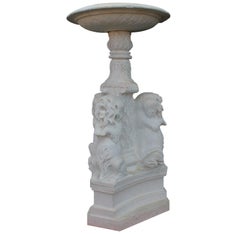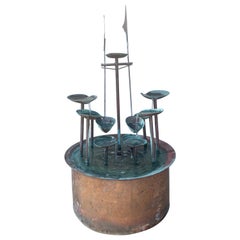Milan - Fountains
2
to
358
225
2
2
2
1
1
1
Height
to
Width
to
2
1
1
2
1
Item Ships From: Milan
20th Century Italian Stone Fountain Mask
Located in Milan, IT
This antique stone mask was probably used in a fountain. It is a very decorative Italian antique object. The mask fits as decorative object on a bureau o...
Category
Early 20th Century European Classical Roman Milan - Fountains
Materials
Stone
Italian Ancient Marble Sculpture Fountain, Late 16th Century
Located in Milano, IT
Sea monster
Carrara marble mouth fountain
Italy, late 16th century
It measures 13.8 x 31.5 x 18.9 in (35 x 80 x 48 cm)
State of conservation: some small evident gaps and widespread signs of wear due to outdoor exposure. The gray marks crossing it do not come from restoration, but are rather the natural veins of the marble.
This work has some morphological characteristics typically associated with the iconography of the sea monster: an elongated muzzle, sharp teeth, protruding eyes, elongated ears, and a coiled serpent's tail.
An in-depth series of studies on artistic depictions of the sea monster attempted to verify how this symbol evolved in antiquity in the European and Mediterranean contexts and how it gradually changed its image and function over time. The iconography itself is mutable and imaginative and its history is rich with cultural and artistic exchange, as well as the overlapping of ideas. This occurred so much that it is difficult to accurately pinpoint the "types" that satisfactorily represent its various developments.
However, we can try to summarize the main figures, starting from the biblical Leviathan and the marine creature that swallowed Jonah (in the Christian version, this figure was to become a whale or a "big fish", the “ketos mega”, translation of the Hebrew “dag gadol”). Other specimens ranged from the dragons mentioned in the Iliad (which were winged and had legs) to "ketos” (also from Greek mythology), the terrifying being from whose Latinized name (“cetus”) derives the word "cetacean". See J. Boardman, “Very Like a Whale” - Classical Sea Monsters, in Monsters and Demons in the Ancient and Medieval Worlds, in Papers presented in Honor of Edith Porada, Mainz am Rhein 1987, pp. 73-84).
In Italy the monster underwent yet further variations: it can be found in Etruscan art on the front of some sarcophagi representing the companion of souls, while among the Romans we find the “Pistrice” (cited by Plinio in Naturalis Historia PLIN., Nat., II 9, 8 and by Virgilio in Eneide: VERG., Aen., III, 427), which appeared in the shape of a stylized hippocampus or a very large monstrous cetacean and evolved into a hideous being with a dragon's head and long webbed fins.
During the Middle Ages, the sea monster was the object of new transformations: at this time, it is often winged, the head is stretched like a crocodile, the front legs are often very sharp fins - sometimes real paws - until the image merges with dragons, the typical figures of medieval visionary spirituality widely found throughout Europe (on this topic and much more, see: Baltrušaitis, J., Il Medioevo fantastico. Antichità ed esotismi nell’arte gotica, Gli Adelphi 1997).
In Italy during the 15th and 16th centuries, the revival of classicism - representative of the humanistic and Renaissance periods - led to a different reading of these "creatures". Indeed, the sea monster was also to find widespread use as an isolated decorative motif, especially in numerous fountains and sculptures where dolphins or sea monsters were used as a characterizing element linked to water (on this theme see: Chet Van Duzer, Sea Monsters on Medieval and Renaissance Maps, London, The British library, 2013).
From the morphological point of view, the "sea monsters" of this period are mostly depicted as hybrid figures, in which the body of a mythological or real being (a hippocampus, a sea snake, a dolphin), is joined to a head with a rather indistinct appearance. It was usually characterized by large upright ears, an elongated snout, sharp teeth and globular, protruding eyes; a complex and indefinite figure, both from the symbolic point of view and from that of its genesis.
The work we are examining is placed as a cross between the medieval sea serpent and the Renaissance dolphin, with stylistic features which recall the snake as often used in heraldry (such as the "snake" depicted in the coat of arms of the Visconti - the lords and then dukes of Milan between 1277 and 1447 - and which, for some, may be derived from the representations of the “Pistrice” that swallowed Jonah).
In the search for sources, Renaissance cartography and in particular woodcuts should not be neglected. See for example the monsters of Olaus Magnus, from the editions of the “Historia de gentibus septentrionalibus” (“History of the peoples of the north”) and the natural histories of Conrad Gesner, Ulisse...
Category
16th Century Italian Renaissance Antique Milan - Fountains
Materials
Carrara Marble
Related Items
Whimsical English 19th-20th Century White Marble Figural Outdoor Dog Fountain
Located in Los Angeles, CA
A Whimsical English 19th-20th century white marble figural fountain with dogs fountain. The Baroque Revival six-sided tripod marble base surmounted with three upright seated Yorkshire Terriers resting on a leaf and acanthus center stem, topped with a semi-circular scalloped carved basin...
Category
Early 1900s English Baroque Revival Antique Milan - Fountains
Materials
Marble
H 60.63 in W 30.5 in D 28.5 in
Wonderful Modernist Kenetic Motion Copper Fountain / Water Feature, Hand Made
Located in Buffalo, NY
Ingenious copper fountain / water feature, solid copper construction, Modernist design Artisan made, hand executed. Sculpture in motion, great for garden, or indoor space.
Category
1970s American Mid-Century Modern Vintage Milan - Fountains
Materials
Copper
Garden Fountain from, Mid-20th Century
Located in Madrid, ES
GARDEN FOUNTAIN OF THE HALF OF THE XX CENTURY
DECORATIVE GARDEN FOUNTAIN FROM THE 50'S IN STONE OR SIMILAR. IT IS COMPOSED OF 3 PARTS. IT IS IN VERY GOOD CONDITION IN GENERAL. MEASU...
Category
1950s Vintage Milan - Fountains
Materials
Sandstone
Art Deco Era Garden Platinum Goliath Heron Crane Fountain Sculptures 6+ feet
Located in Las Vegas, NV
Magnificent pair of life-size+ bronze Goliath Heron fountain sculptures from the Art Deco era.
What sets these apart from all others is their silver pl...
Category
Mid-20th Century Art Deco Milan - Fountains
Materials
Bronze
H 78 in W 32 in D 14 in
Copper Mermaid Fountain by Glen Mayo
By Glen Mayo
Located in West Palm Beach, FL
Whimsical fountain sculpture, of copper, by metal artist Glen Mayo; its mermaid focal point holding a leaf which cascades water down the fountain, among turtles, angel fish, other se...
Category
1990s North American Milan - Fountains
Materials
Copper
Italian 19th-20th Century Whimsical White Marble Wishing Wellhead with Children
Located in Los Angeles, CA
A very fine and exceptionally carved Italian 19th-20th century Baroque Revival style whimsical white Carrara marble wishing wellhead, raised on an octagonal two-step marble base. The intricately carved marble relief circular wellhead depicting carved figures of dancing and cheerful children (Putti) among vines, flowers and fruits, dancing and playing musical instruments with a backdrop of castles, landscapes, forests and wreaths, Florence, circa, 1900.
Literature:
A similar wellhead was sold by Jan's & Co. Fine French Antiques, Inc. in 1999, provenance the Atkinson/Kirkeby Estate and it is illustrated in "The Estates of Beverly Hills" by Charles Lockwood and Jeff-Hyland, page 150.
Another similar is currently on display at the gardens of "The Elms" mansion a public museum part of the Newport Mansions by The Preservation Society of Newport County in Newport, Rhode Island.
Yet another similar wellhead carved with frolicking putti with musical instruments and a dentil molded rim is located at Cranbrook House, Bloomfield Hills, Michigan, and is illustrated in B. Israel, Antique Garden Ornament...
Category
Early 1900s Italian Baroque Revival Antique Milan - Fountains
Materials
Carrara Marble
Antique French Stone Fountain Piece with Triple Dolphin Spouts, Circa 1900
Located in Dallas, TX
This charming French fountain piece with triple dolphin spouts was made circa 1900. The dolphins are made from reconstituted stone, which is natural lim...
Category
Early 1900s French Antique Milan - Fountains
Materials
Stone
H 17.5 in W 13.25 in D 10 in
American Giant Stone Frog with Patina, Originally Used as a Fountain
Located in Atlanta, GA
An American giant stone frog from the 20th century, with great patina. Made in the USA in 1987, this giant stone stone frog used to be a fountain (notice the remnants of a pipe below...
Category
1980s American Vintage Milan - Fountains
Materials
Stone
Wooden Carved Black Forest Garden Fountain Water Spout 19th century
Located in Berghuelen, DE
Wooden Carved Black Forest Garden Fountain Water Spout 19th century
A large Black Forest wooden carved water spout featuring "Ruebezahl", which is the mountain spirit of the giant m...
Category
Late 19th Century German Black Forest Antique Milan - Fountains
Materials
Wood
Classical Figural Painted Cast Stone Tiered Garden Fountain, 20th C
Located in Big Flats, NY
A Classical garden fountain offers painted cast stone construction with young boy over tiered fountain with tiered shell form bowls raised on reeded Doric columns, 20th century.
Mea...
Category
20th Century Classical Greek Milan - Fountains
Materials
Concrete, Cast Stone
Rare Cocobolo Don Shoemaker Fountain, Organic Mexican Mid-Century Modern, 1960s
By Don S. Shoemaker
Located in San Diego, CA
Exceptional one of a kind organic midcentury Mexican modernist fountain designed by Don Shoemaker.
Don Shoemaker fountain is made of Cocobolo woo...
Category
Mid-20th Century Mexican Mid-Century Modern Milan - Fountains
Materials
Cocobolo
H 25 in W 22 in D 22 in
Large Water Fountain Elephant Garden Scuplture, Mid-20th Century
Located in South Salem, NY
A delightful and playful concrete baby elephant water fountain, originating from mid-20th century England. This charming piece captures the essence of a seated baby elephant, infusin...
Category
Mid-20th Century English Milan - Fountains
Materials
Concrete
Recently Viewed
View AllMore Ways To Browse
Hand Carved Limestone Wall Fountain
Antique Stone Wall Fountain
Antique Stone Water Fountain
Small Wall Fountain
Wall Fountain Spout
Used Outdoor Fountains
Garden Fountain Lion
Large Italian Limestone
Rectangular Fountains
Round Garden Fountain
Large Antique Garden Fountain
Greece Outdoor
French Cast Iron Fountain
French And Hollywood Patio Furniture
Fountain Pump
Shell Basin
Garden Water Trough
Hollywood Mediterranean


